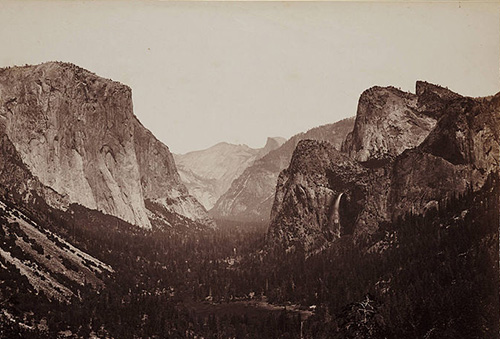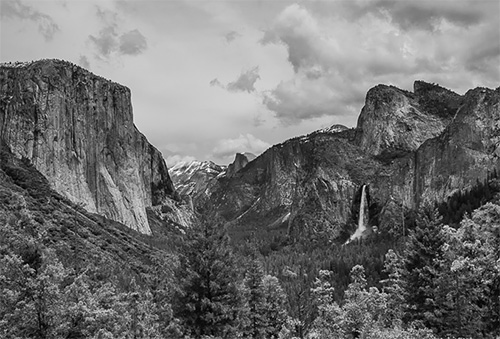Photo Corners headlinesarchivemikepasini.com
![]()
A S C R A P B O O K O F S O L U T I O N S F O R T H E P H O T O G R A P H E R
![]()
Enhancing the enjoyment of taking pictures with news that matters, features that entertain and images that delight. Published frequently.
Visiting Watkins At Stanford




12 May 2014
After our Friday slide show of Yosemite, we decided to take the trip down the peninsula to the Cantor Arts Center at Stanford to see Carleton Watkins' images of Yosemite in 1861. Could there be a longer gap between images of the same places?
There wasn't much technical information at the otherwise well-documented exhibit so we thought we'd fill in the gap. We overheard one visitor asking why there were no people in the images and another wondering why there were no clouds in the sky.
Let's see if we can explain both of those puzzles.
ENOUGH MULES
In 1861 Watkins loaded a dozen mules with "nearly a ton of photographic equipment including a mobile darkroom tent, a dangerous assortment of flammable chemicals, and an enormous custom-built "Mammoth" camera that produced 18x22-inch glass-plate negatives." He led the pack 75 miles into Yosemite Valley fighting heat, dust and dirt to expose his wet-plate negatives for up to an hour.
Featuring clear whites and minute detail, these large negatives were contact printed to produce stunning landscapes.
THE WET PLATE
Building on the work of Joseph Nicéphore Niepce, Louis Jacque Mandé Daguerre and William Henry Fox, the British inventor Frederick Scott Archer produced the first wet glass plate negative in 1851. Gustave Le Gray is also acknowledged as a simultaneous inventor of the process, we should add.
The process was detailed in several manuals of the 1860s before John Towler published The Silver Sunbeam in 1864, outlining the new photographic process in just ten steps). Here's the Getty Museum's video of the entire process:
To make a wet plate, you dissolve a bromide, iodide or chloride in collodion, which is a flammable liquid made of cellulose nitrate and ether. Let that age a while.
Then you pour the mixture on a clean glass plate and let it sit until the coating gels but is still wet. Then, in a dark room, you submerge the glass plate in a silver nitrate bath, turning the collodion gel into a photosensitive silver iodide. When the chemical reaction is complete after three to five minutes, the plate is loaded into a holder and is ready for the camera.
The longer it dries, though, the less sensitive it becomes. So if you were shooting portraits in the studio and needed a short exposure to capture your animated subjects, you used it right away. But if landscapes were your subject, you could afford an exposure like Watkins' hour-long images, so you had a little more time to let the plate sit around.
Of course, in an exposure that took minutes to make, moving objects like people and wagons and horses would not remain in one place long enough to register an exposure. They simply disappear in the negative as whatever they passed by _did_ have time to register on the emulsion.
A plate would dry in about five minutes, so a typical workflow would include sensitizing, exposing and developing within 15 minutes. The process made a mess of the studio and camera, too.
After exposure, the plate was heated and coated with varnish (which can actually dissolve the image) to protect the new negative, which can then be used to make many detailed contact prints, typically on albumen paper resulting in a reddish color (as in Watkins' prints).
SENSITIVITY
Wet plates were orthographic, sensitive only to blue light, or to put it another way, unable to separate blue from white or red from black.
So landscapes made with wet plates never captured clouds in a blue sky. The white clouds are indistinguishable from the blue sky. That led some early photographers to paint clouds onto their negatives.
But it also makes it difficult to distinguish red bark from black shadows. Shadow detail in Watkins' landscapes can disappear, too.
To illustrate the effect, we've reproduced our shot from Inspiration Point in 2011 with a crop of Watkins' shot from nearly the same spot in 1861. Click either to see a larger image, although the larger Watkins is also uncropped.
The orthographic sensitivity of his wet plates also explains the ghostly granite walls of the valley in some of his images. You can see the effect a bit in the image above, in fact.
The foreground would be a dark forest with some granite peak rising meekly behind it, almost as wispy as a cloud. But because the rock was in the distance, atmospheric haze would make it more blue than gray and it would disappear into the white (well, blue) sky.
It appeared that at least on one of those images, though, Watkins had dodged the effect, with a foreground tree a little lighter where it obscured the granite behind it.
THE SHORT VERSION
So the long landscape exposures explain why anything moving was not captured on the negative. And the orthographic sensitivity explains why there were no clouds in the sky.
Both phenomena are common in images of that era.
WATKINS
It was a treat to see the 18x22 prints. Watkins arranged the images in his Photographs of the Yosemite Valley, shot in 1861 and 1865-1866, to replicate the experience of entering the Mariposa Grove trail and traveling into the valley from Cathedral Rocks to Half Dome.
Also on exhibit are images from his Photographs of the Pacific Coast album, taken between 1862 and 1876 (which include shots of San Francisco), and his Photographs of the Columbia River and Oregon album from 1867 and 1870.
Born in Oneonta, N.Y. In 1829, Watkins went to San Francisco in 1851 during the gold rush. He worked in San Francisco portrait studios until he opened his own in 1961.
He distinguished himself with his landscapes of Yosemite using his custom Mammoth camera, influencing Congress' decision to establish the valley as a National Park in 1864.
His named his San Francisco studio Yo-Semite Gallery, playing on the fame of his landscapes. He also continued his survey of the west, photographing Lake Tahoe, Virginia City, southern California, Arizona, the Pacific Northwest and Yellowstone, capturing thousands of images.
He was in fact having them catalogued with the intent of housing them at Stanford University when the 1906 earthquake and fire ravaged San Francisco. His studio, with all of his negatives, were destroyed.
He never recovered from the loss. In 1910 he was committed to Napa State Hospital for the Insane where he died June 23, 1916.
Though his negatives were destroyed, his prints survive in many private and institutional collections. And the Cantor exhibit presents Stanford's holdings.
(Stanford University Press has published the 280-page "Carleton Watkins: The Stanford Albums" in hardcover at 11.2 x 14.2 inches for $30.60. It's an impressive volume with over 150 images from the albums plus 15 essays. -- Editor)

